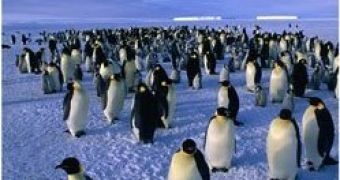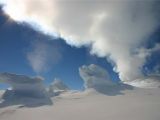Of the seven continents, Antarctica detains some superlatives: it is the coldest (the record: - 94.5Oc), the driest (20 mm annually), the most remote and the highest continent (average height of 2,450 m or 8,170 ft).
Asia is just 960 m (3,200 ft) high, Africa 750 m (2,500 ft), North America 720 m (2,400 ft), South America 590 m (1,760 ft) and Europe and Australia 340 m (1,133 ft).
Almost all of its mass land is located south of the Polar Circle (66 o 33' S).
The closest continent, South America, is located at 850 km (520 mi), while from Australia the distance is of 3,100 km and from Africa 4,000 km.
It has the highest atmospheric pressure, 1156 mb, much more than in the Siberian Oimiakon point (with 1,036 mb). This continent experiences the strongest winds (60 m/s), the drain winds, which fall with unimaginable speed from the ice cupolas to the shores. Antarctica was first stepped in 1820 by the Russian explorers Bellinghausen and Lazarev.
Its surface is estimated from 13,900,000 to 14,200,000 square kilometers, a tenth of the Earth's ground. Many believe that Antarctica is in fact a large group of islands and not a sole continuous continent, but this is hard to see as just 1 % of the continent's surface (140,000 square kilometers) is free of ice and those islands would be bound by thick ice pack.
The rest is covered by an ice pack 2 to 3,000 m (6 to 10,000 feet) thick, the average being 2200 m. Antarctica's ice has a volume of 29.46 million cubic kilometers and represents 90 % of the freshwater reserve of the planet. The ice pack is advancing into the sea with even 200 m (660 ft) annually and this affects the scientific camps from Antarctica and the ice pack can extend 500-600 km (310-370 mi) from the shore.
Modern technology revealed several freshwater lakes under the ice pack, the largest, Lake Vostok, being 150 km (95 miles) long, formed after the melting of the lower part of the ice due to the heat from the deep Earth. Vostok Lake covers 14,000 square km and it is filled with freshwater, mud and acid fluids, being in some places 500 m (1,660 ft) deep. The under ice lakes could be caused by geothermal water flow, coming from the deep layers of the Earth. The lakes are protected from the external freeze by the ice pack.
The so-called summer lasts only two months and meanwhile, in the most sheltered places, scarce vegetation develops, mainly likens.
The shore's average annual temperature is -10 - -20o C.
In Antarctica it rains only on the Graham land and the longest river is Onix River (30 km or 19 mi long) from the Rait Oasis. There are places in Antarctica where rivers can emerge directly from the ice. In some places, the air humidity can be 5 %, like in the deserts of Gobi or Kalahari.
The Transantarctic Mountains split the continent in two.
Eastern Antarctica, situated in the Eastern Hemisphere, is a huge oval zone representing an old continental block with a 10,433,000 square kilometers surface, made of very old rocks covered by younger sediments (marine or from lakes), raised by the recent mountains' formation.
The Western Antarctica (Lesser Antarctica) with 3,532,000 square kilometers has alpine peaks connected with alpine chains in South America, that's why they are called the Antarctic Andes.
It preserved its features even after the separation from Gondwana (the southern continent reuniting also South America, Africa, India and Australia).
Erebus is located on the Ross Island, not only the sole active volcano of Antarctica, but also the world's most southern active volcano. The volcanic cone, formed by four craters, is almost completely covered by ice. Erebus has a height of 3,795 m (12,650 ft) and received its name after a ship of an 1841 expedition in Antarctica.
The highest peak in Antarctica is "Committee Range", 6096 m. The geographic South Pole is located at a 2804 m altitude.
Due to the lack of impurities, the radiation intensity is high and grows with the altitude; at 3,000 m during summer it can reach 1.7 kcal/cmp/min, like that of the almost ideal transparency. Direct radiation in Antarctica is of 60-80 % while in Arctic is of just 20-30 %, due to the high turbidity. Antarctica is also the richest place on Earth where meteorite fragments have been found.
Geological structures found in Antarctica are similar with some found in Africa, Australia, enhancing the theory that these continents, together with South America and India were once part of a southern supercontinent called Gondwana.
A marsupial fossil proved that marsupials entered Australia from South America using Antarctica as a land bridge. Fossilized crocodiles, plesiosaurs (a type of large long necked marine reptiles from dinosaur era) and wood point that 70 million years ago, during the dinosaur era, this was a tropical heaven.
Drilling in the zone of the Ross Sea indicated hydrocarbons' presence. Geophysicians estimate Antarctica's deposits at 45 billion oil barrels. Geological data show that Antarctica possesses the largest carboniferous basin in the world. The Transantarctic Mountains contain along their length (over 3,000 km (1800 miles)) high quality carbons. Carbon was also found in the Prince Charles Mountains.
In the Prince Charles Mountains, Mac Robertson Land, Dronning Maud Land iron ore was found. Also, zinc, lead, gold, silver, molibdenum, nickel, crom, cobalt and uranium ores were discovered.
Antarctica's life is made by about 1,200 animal species and 400 plant species.
Almost all life in Antarctica is linked to the sea: seals, whales, penguins, gulls, fulmars and so on. On the only land patches where little vegetation of moss and likens (vascular plants almost miss) grow, an abundant insect life can thrive.
Antarctica's only settlements are the scientific camps, made of 2-3 houses built from double aluminium, having between an isolating spongy material and raised on metallic pylons of about 2 m (6.6 ft), a meteo lab, 2-3 labs destined for geological, geographical, astronomy, cartography, glaciology and other types of research; a dispensary, a small power plant, a radio-emission station, a library, meeting room, dinner room, cooking room, food store.
Biological studies stations are usually located near the seashore.

 14 DAY TRIAL //
14 DAY TRIAL // 
